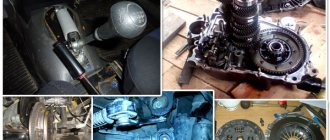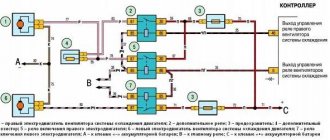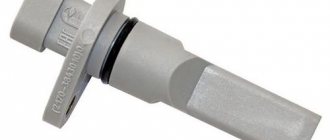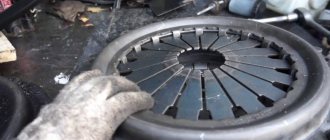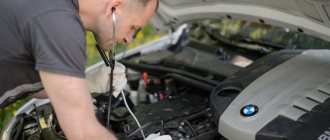The clarity of gear engagement and the operation of the entire shift mechanism often worries owners of cars with a manual transmission. A common problem is that after starting the engine, one or more gears are engaged with great effort or not completely, it is not possible to change gears, at the moment of switching on, extraneous noise is heard, unnecessary vibrations appear, etc.
We also recommend reading the article on how to repair a crack in the cylinder block or cylinder head. In this article, you will learn about various methods for repairing cracked engine block and head.
Such malfunctions appear unexpectedly, and difficulties when shifting gears can increase gradually. Speeds may be difficult to switch on “cold” and/or “hot”. It is noteworthy that gears in a manual transmission often shift normally when the engine is turned off.
Recommendations
Comments 21
It’s the same for me. I turn on the second one with force, but I don’t see the point in turning on the first one on the go. The engine runs fine at low speeds.
Synchronizers 1 and 2 are covered, I also turn on the first one at low speed - neutral - gas - clutch, the first one is like on a truck. and from 3rd to 2nd with transfer (but not on the clutch, but through the neutral gearbox!).
Was 3110 2000. Same behavior of the box. Only the second one is more or less normal. turned on. The first one did not turn on at all while driving. Now 31105 2004 The gears turn on normally. The first one turns on tighter while moving.
My father has the same problem on the Volga. Gas 24, the box is plugged in from 31st 5st. So the first one turns on only when the car is stationary; if you start moving, you can’t turn on the first one. The second one sticks in sooo hard, you have to sweat, nothing crunches, it just fits in very tight. The rest of the gears are like clockwork, and second and first cannot be engaged either. This is a CAT disease, and specifically stage 5. With 4speed this is not observed, everything turns on like clockwork)
When the speed of the car begins to turn on heavily, it not only causes an unpleasant feeling, but also makes the operation of the car unsafe. In this article we will analyze the reasons why gears are difficult to engage or do not shift at all, which is usually associated with this.
The gearbox is a complex mechanism that requires constant maintenance. Including regular diagnostics and gearbox oil changes. Ignoring these measures often leads to problems with gear shifting.
New or refurbished old?
If replacing the gearbox cannot be avoided, it is worth considering one very attractive option - installing a rebuilt gearbox. To do this, companies purchase old, damaged boxes, restore them to the highest possible quality and offer installation with a guarantee.
As practice shows, such gearboxes are approximately 30-70% cheaper than purchasing a new gearbox.
There is only one important condition for successful savings on such significant repairs. It must be a reliable, proven company. Such companies value their own reputation, therefore they do not deal with fakes or low-quality repairs
In order to receive positive customer feedback and attract new customers, they simply must do everything well, conscientiously. That’s why today there are fly-by-night companies and companies where, over the years of work, they have established themselves as a reliable and responsible specialist in repairing and replacing gearboxes. You yourself understand perfectly well who you need to contact if you have problems with your box.
Such companies value their own reputation, so they do not deal with fakes or low-quality repairs. In order to receive positive customer feedback and attract new customers, they simply must do everything well, conscientiously. That’s why today there are fly-by-night companies and companies where, over the years of work, they have established themselves as a reliable and responsible specialist in repairing and replacing gearboxes. You yourself understand perfectly well who you need to contact if you have problems with your box.
What are the reasons for poor gear shifting?
Difficulty shifting gears can occur as a result of improper operation of the gearbox, or due to operation of the vehicle on bad roads. Problems with the gearbox sooner or later occur in used cars.
If you have difficulties when trying to switch to another gear, you cannot shift or it takes a lot of effort, then there is clearly a malfunction. Most often, car owners turn to a car service center when they have difficulty engaging first gear or reverse gear . A fairly common problem on VAZ and Ford Focus cars.
Let's look at the faults that lead to difficult gear shifting:
- Clutch malfunction. In this situation, the gears will engage either poorly or not completely. A common occurrence in VAZ cars that have fur cables. the clutch is moving away from the mount.
- Problems in the drive of the switching mechanism. Broken traction leads to difficult engagement of 1st and reverse gears.
- The jet thrust is faulty.
- Wear of plastic parts in the box control drive.
- The slide is incorrectly positioned. A weighty element, incorrect adjustment leads to malfunctions.
- Bearing wear. This is a fairly rare occurrence; anyone can experience this, especially when you have a manual transmission. In such a situation, it is usually difficult to engage first gear.
- The box shaft is faulty. By itself, it is not subject to heavy loads, which could lead to wear. A factory defect may cause the entire unit to be replaced.
- Clutch failure. Often found among owners of cars with an automatic transmission. The malfunction is eliminated by replacing the clutches.
- Faulty synchronizers are the most common problem among gearbox breakdowns. They are made of brass, and this metal itself is quite soft. During use, it wears out and wears out. The breakdown is usually accompanied by a grinding noise when switching to another speed.
Why is it difficult to engage manual transmission gears?
manual gear shifting
- The most common problem is clutch failure. In such a situation, reverse gear turns on with a bang. This happens because the gear overlaps the tooth. Reverse speed is the only gear in the box that does not have synchronizers. For this reason, clutch failure is so obvious on it.
- The second reason is a defect in the mechanism responsible for selecting the gear. This breakdown occurs when the car is stationary and you try to shift into gear.
- The third is severe wear of the gearbox synchronizers. Mostly, breakdowns occur with those that are most often used. These are first, second and third gear. Severe wear of the synchronizers only appears when switching while driving.
To prevent possible gearbox malfunctions, perform regular maintenance, change the oil on time, and in case of minor failures, rush for diagnostics . This will save you time and money in the future.
Watch the video for what not to do with a manual transmission:
What to do if it is difficult to engage reverse gear?
If you have difficulty engaging reverse gear, do one of the following :
- When you feel that the gear has not reached the end, release the clutch slightly, and the gear will be inserted all the way.
- Fully depress the clutch and only after a few seconds engage reverse gear.
- Depress the clutch, set the gear to neutral and release the clutch. After this, press down and engage reverse gear.
- Shift into reverse through another gear. For example, first engage 4th and then shift to reverse.
How to properly engage reverse gear on a Hyundai Solaris, watch the video:
It's hard to engage first gear
Many drivers who encounter this situation try to force the gearbox selector to engage 1st speed. But this is fundamentally wrong and should not be done this way.
In this situation, it is necessary to use the regas method . Its essence is as follows:
- While driving in second gear, depress the clutch and set it to neutral and then release the clutch.
- After this, you need to press the gas pedal, increasing the speed to 2.5 thousand.
- The next step is to engage the clutch again by pressing the pedal all the way and turn on the first gear on the gearbox. If you still have difficulties with this, then you need to repeat it, because... You gave too little gas, there were too few revolutions.
- If all the steps are performed correctly, the first speed will turn on without any difficulties or sounds.
However, this method should not be used on an ongoing basis when it is difficult to engage 1st gear. This method is temporary in order to at least get to the service station without any problems. In any case, the box will have to be repaired.
Problems with automatic shifting
An automatic transmission is very demanding in maintaining the oil level and its condition, unlike a manual transmission. Too high or low oil level can lead to machine malfunction. In addition, due to a lack or excess of oil, difficulties may arise in switching gears.
The most common automatic transmission faults:
- Forward gears do not engage.
- There is no reverse gear, forward there is only 1st and 2nd.
- All speeds are engaged except reverse.
- The gears don't engage at all.
The oil level in the automatic transmission is checked using a dipstick. If the oil level is low, add.
Theory of gearbox operation
At the moment, all modern gearboxes are equipped with synchronizers, which are important elements of the gearbox. The essence of how synchronizers work is that they equalize the operation of the gearbox shafts.
Every driver, when switching from second to first gear, has encountered a situation where some kind of obstacle was felt. What prevents you from engaging first gear while driving. This is the synchronizer.
If you have a fairly new transmission, then when switching from an upshift to a downshift you will not find yourself in such a situation. Switching will be carried out without problems. This manifests itself as the components of the unit are used and worn out.
If you have problems with switching, come to Ankara for diagnostics and repair of transmissions of Mitsubishi, Toyota, Lexus, Land Rover, Jaguar, Infiniti, Mercedes, BMW, Audi and other brands.
Watch a video about the design and operating principle of the gearbox:
Owners of cars with a manual transmission often encounter the problem of poor gear engagement, which occurs after starting and warming up the engine, that is, “on hot”. In this case, engaging one or more gears may not only be difficult, but also be accompanied by extraneous noise or unnecessary vibrations.
In this case, the gearbox shifts normally when the engine is turned off. Next, we will look at the common reasons why this malfunction occurs, as well as what to do if the gears are difficult to engage when heating.
Read in this article
Drive and clutch cables
For rear-wheel drive models (VAZ 2101 - 2107), the gears are engaged hydraulically. That is, when you press the clutch, the fluid pushes the piston, which in turn pushes the clutch fork, which retracts the disc. For front-wheel drive models (VAZ 2108 - 2115), there is no hydraulic connection; everything is done here by mechanics, or rather by the clutch cable, which is connected to the pedals. If your slave cylinder leaks on a rear-wheel drive car or the cable breaks on a front-wheel drive car, the car will not engage in gear. The “fork” simply won’t work. We just check and replace damaged parts.
Gears are difficult to engage when hot: the main causes of manual transmission malfunctions
The manual transmission is designed to transmit torque from the internal combustion engine to the drive wheels of the car, as well as stepwise change the gear ratio. In a manual transmission, gears (steps) are changed manually by the driver, who also selects the optimal gear ratio, ensuring the best operating mode of the internal combustion engine while the vehicle is moving.
In the case when problems switching speeds occur when the internal combustion engine is warm, the main symptoms can be identified:
- Reverse gear is difficult to engage;
- shifting gears from high speed to low speed and vice versa is accompanied by extraneous noise, grinding or crackling;
- complete lack of ability to change gears;
The main causes of manual transmission malfunctions:
- low oil level in the box;
- the link is poorly adjusted or damaged;
- problems with the clutch mechanism;
- destruction or deformation of gears;
- wear of shaft bearings;
- failure of synchronizers.
So, often when heated, gears are difficult to engage due to low oil level in the manual transmission. Taking into account the decrease in the level of lubricating fluid, the coefficient of friction between the rubbing parts increases, which leads to difficult and unclear gear shifting.
- Often the reverse gear is not engaged “in hot” mode due to a malfunction of the linkage. This is a common cause of problems with reverse gear engagement, which occurs when the rocker mechanism is incorrectly adjusted or worn. In fact, a tolerance shift occurs when the gear shift mechanism moves (as a result of wear of the rocker joints or adjustment failure).
Operating manual for walk-behind tractor Neva MB-23B-8.0
The small-sized device is equipped with trailed and mounted implements for plowing, loosening, and cultivating the soil. The operating instructions introduce the user to the general provisions, which contain information regarding the operation of the walk-behind tractor, maintenance and storage of the unit.
The instruction manual contains information about possible malfunctions and tips for eliminating them. The instructions indicate the engine features for any modification of the walk-behind tractor.
The manual for the Neva Compact walk-behind tractor indicates the purpose of the main parts of the unit:
- gearbox;
- cutter clutch mechanism;
- hitch bracket;
- cultivation depth limiter.
The user, having familiarized himself with the control mechanism of the walk-behind tractor, determines how to increase the speed when plowing heavy soil. The instructions indicate a lever that allows you to change gears with the engine running and the clutch disengaged to the nearest neutral gear.
Accelerated operation of the motor with distorted vibration is a reason to inspect the walk-behind tractor and repair damage. If the edges of the knives are damaged, the usual set of cutters is completely replaced.
What's the result?
As you can see, there are several main reasons why gears don’t engage well when hot. However, none of the above reasons can be indirect or secondary.
The main thing is to promptly correct the slightest problems, prevent leaks, monitor the oil level in the box, adjust the rocker, change the clutch when signs of wear appear, etc.
Why gears on a manual transmission are difficult to engage: the main reasons for difficulty engaging manual transmission gears. Clutch and transmission failures.
Manual transmission gears (speeds) do not engage after replacing the clutch: main reasons, settings and adjustments. Diagnosis of problems, useful tips.
Types of clutch drive. If the clutch pedal falls, the clutch has become soft, problems have arisen with the clutch: causes and repair of major faults.
Reasons for difficulty shifting gears with the engine running. Transmission oil and level in the gearbox, wear of synchronizers and gearbox gears, clutch.
Manual transmission: manual transmission diagnostics, repair of a car's manual transmission. What to look for during diagnosis, recommendations.
The automatic transmission does not change gears: the car does not move forward or backward, the automatic transmission does not switch to individual gears, reasons.
Unit repair
The owner studies the structure of the walk-behind tractor and corrects faults in a timely manner. When the engine is running, ignition may occur, black smoke may come out of the muffler, and carbon deposits may form on the spark plug.
In this case, it is necessary to disassemble the air filter and clean it. If the spark is lost, the engine does not start, and the spark plug is wet, the reasons for the failure in the ignition system are determined. The owner of the walk-behind tractor cleans the electrodes, rinses and dries the parts. It is necessary to disassemble the walk-behind tractor engine, observing the following rules:
- drain the oil from the crankcase;
- install the filler plug;
- Disconnect the hose and air filter.
Next, you should dismantle the remaining parts of the engine. Before assembling the engine, parts are cleaned of dirt and components to be installed are washed. When setting up the crank mechanism, check the suitability of the oil scraper rings for operation.
Piston rings are replaced only as a set.

